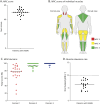Nemaline Myopathy Type 6 Caused by Variants in the KBTBD13 Gene: A Cross-Sectional Study of 24 Patients
- PMID: 39651462
- PMCID: PMC11623396
- DOI: 10.1212/NXG.0000000000200214
Nemaline Myopathy Type 6 Caused by Variants in the KBTBD13 Gene: A Cross-Sectional Study of 24 Patients
Abstract
Background and objectives: Nemaline myopathy type 6 (NEM6) is the most prevalent type of nemaline myopathy in the Netherlands. Because a detailed clinical characterization is not available yet, we here provide a detailed assessment of 24 patients.
Methods: In this cross-sectional study, we performed a full clinical assessment (medical history and neurologic examination) in patients with NEM6. Patient demographics, causative variants in the KBTBD13 gene, creatine kinase levels, and the results of previous muscle biopsies were collected. We evaluated experienced health-related quality of life, fatigue severity, prevalence of falls, balance control (Mini-Balance Evaluation Systems Test [Mini-BESTest]), functional motor score (Motor Function Measure [MFM]), and 6-minute walk distance. We used transcranial magnetic stimulation to assess muscle relaxation kinetics.
Results: Twenty-four patients were included (19 women [19-76 years]; 5 men [25-57 years]). Key patient-reported symptoms since childhood were muscle weakness (n = 23; 96%), slowness of movements (n = 23; 96%), and difficulties with running (n = 20; 83%). Axial, proximal, and distal muscles showed mild weakness in most patients. Health-related quality of life was significantly lower, and there was a significantly increased fatigue severity compared with controls. Prospectively, in a period of 100 days, 8 patients (33%) fell at least 1 time, of whom 5 patients (21%) fell 2 times or more. The median total score on the Mini-BESTest was 24 (21.0-26.0 [interquartile range]) of 28 and the median total percentage on the MFM was 91% (83.5-95.3), both considered to be mildly abnormal. The 6-minute walk distance was below the lower limit of normal in 4 patients (17%). All patients with NEM6 showed a markedly reduced muscle relaxation rate with a median of 6.5 [4.9-8.1] s-1 (lower limit of normal is 10.1 s-1).
Discussion: This cross-sectional study in patients with NEM6 shows a relatively mild clinical phenotype and mildly abnormal functional tests. However, patients report an important impact on the daily activities, which is illustrated by functional difficulties, reduced quality of life, increased fatigue severity, and increased prevalence of falls. This might be related to delayed muscle relaxation. This study provides a comprehensive overview of the clinical presentation and functional limitations in patients with NEM6.
Copyright © 2024 The Author(s). Published by Wolters Kluwer Health, Inc. on behalf of the American Academy of Neurology.
Conflict of interest statement
The authors report no relevant disclosures. Go to Neurology.org/NG for full disclosures.
Figures


Similar articles
-
A Likely Pathogenic variant in the KBTBD13 Gene: A Case Series of Three Patients with Nemaline Myopathy Type 6.J Neuromuscul Dis. 2024 Nov;11(6):1300-1307. doi: 10.3233/JND-230196. J Neuromuscul Dis. 2024. PMID: 39240645
-
NEM6, KBTBD13-Related Congenital Myopathy: Myopathological Analysis in 18 Dutch Patients Reveals Ring Rods Fibers, Cores, Nuclear Clumps, and Granulo-Filamentous Protein Material.J Neuropathol Exp Neurol. 2021 Mar 22;80(4):366-376. doi: 10.1093/jnen/nlab012. J Neuropathol Exp Neurol. 2021. PMID: 33693846
-
KBTBD13 is an actin-binding protein that modulates muscle kinetics.J Clin Invest. 2020 Feb 3;130(2):754-767. doi: 10.1172/JCI124000. J Clin Invest. 2020. PMID: 31671076 Free PMC article.
-
Sporadic late-onset nemaline myopathy: clinico-pathological characteristics and review of 76 cases.Orphanet J Rare Dis. 2017 May 11;12(1):86. doi: 10.1186/s13023-017-0640-2. Orphanet J Rare Dis. 2017. PMID: 28490364 Free PMC article. Review.
-
Behavioural modification interventions for medically unexplained symptoms in primary care: systematic reviews and economic evaluation.Health Technol Assess. 2020 Sep;24(46):1-490. doi: 10.3310/hta24460. Health Technol Assess. 2020. PMID: 32975190 Free PMC article.
References
LinkOut - more resources
Full Text Sources
